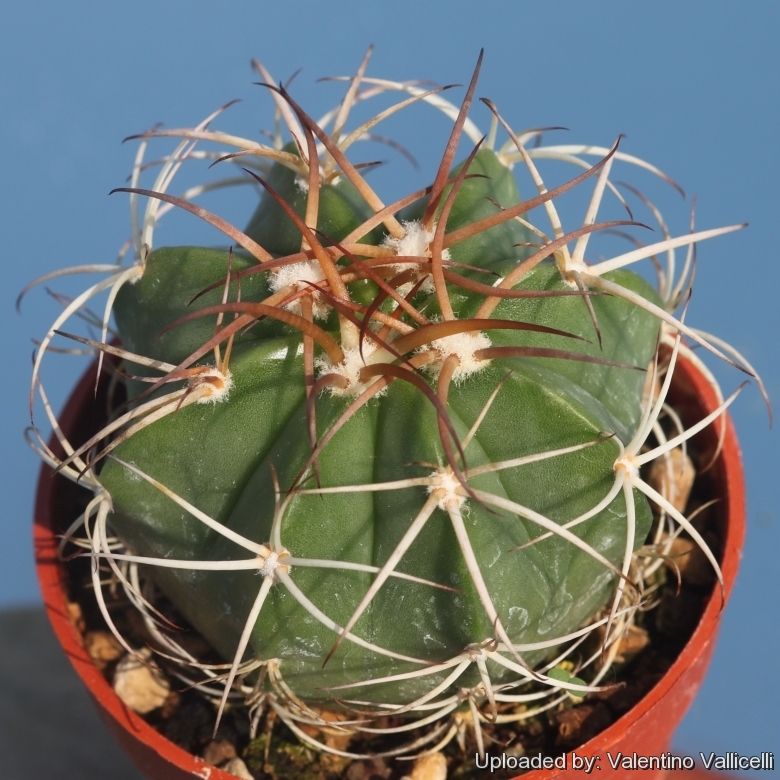




Your support is critical to our success.

KK447 (Collector: Karel Kníže) Locality: Nazareth, Rio Maranon, Peru Altitude: 900m (600m in 1977 list)
Origin and Habitat: Nazareth, Rio Maranon, Peru.
Altitude: 600(-900?) m over sea level.
Synonyms:
- Melocactus pygmaeus Kníže
ENGLISH: Melon, Melon Cactus, Turk’s Cap
Description: Melocactus pygmaeusSN|20610]]SN|23778]] (Field number: KK 447, collected by Karel Kníže near Nazareth, Rio Maranon, Northern Peru) is an unpublished catalogue name (nomen nudum), unusual among the Melocacti from that area in producing the cephalium on relatively small plants. It is thought to be a dwarf form of Melocactus bellavistensisSN|23778]]SN|20610]].
Subspecies, varieties, forms and cultivars of plants belonging to the Melocactus bellavistensis group
 Melocactus bellavistensis Rauh & Backeb.: has 12-18 ribs, central spines are absent or small. Distribution: Ecuador and northern Peru.
Melocactus bellavistensis Rauh & Backeb.: has 12-18 ribs, central spines are absent or small. Distribution: Ecuador and northern Peru.- Melocactus bellavistensis subs. onychacanthus (F.Ritter) N.P.Taylor: has 9-12 ribs, and 0-3 central spines. Distribution: Northern Peru.
 Melocactus pygmaeus Kníže: is a dwarf form producing the cephalium on relatively small plants. Distribution: Nazareth, Rio Maranon, Peru.
Melocactus pygmaeus Kníže: is a dwarf form producing the cephalium on relatively small plants. Distribution: Nazareth, Rio Maranon, Peru.
Notes: The most remarkable part of a Melocactus is its cephalium a bristle-coated structure on the summit of the plant, only Melocactus, and the similar genus Discocactus possesses this type of permanent, apical, hatlike appendage. It’s only when Melocactus s reaches maturity that the cephalium begins to grow. Cylindrical, with a diameter distinctly smaller than that of the plant body below, the cephalium will keep growing for the rest of the plant’s life, but the body of the plant stops growing the moment the cephalium starts to form. . As the plants age the cephalium doesn’t increase in circumference it will steadily grow taller.
Bibliography: Major references and further lectures
1) Stuart Max Walters “The European garden flora. 3.[Angiospermae], Dicotyledons. [Casuarinaceae to Aristolochiaceae]” Cambridge University Press, 1989
2) Edward Anderson “The Cactus family” Timber Press, Incorporated, 2001
3) David R Hunt; Nigel P Taylor; Graham Charles; International Cactaceae Systematics Group. "The New Cactus Lexicon" dh books, 2006
4) Urs Eggli, Leonard E. Newton "Etymological Dictionary of Succulent Plant Names" Birkhäuser 2004
5) Gunnar Harling, Benkt Sparre “Flora of Ecuador” Department of Systematic Botany, University of Göteborg, Section for Botany, Riksmuseum., 1989
6) Ostalaza, C. & Loaiza, C. 2013. Melocactus bellavistensis. In: IUCN 2013. "IUCN Red List of Threatened Species." Version 2013.1. <www.iucnredlist.org>. Downloaded on 09 November 2013.
7) Brako, L. & J. L. Zarucchi. (eds.) 1993. "Catalogue of the Flowering Plants and Gymnosperms of Peru." Monogr. Syst. Bot. Missouri Bot. Gard. 45: i–xl, 1–1286.
8) Jørgensen, P. M. & S. León-Yánez. (eds.) 1999. "Catalogue of the vascular plants of Ecuador." Monogr. Syst. Bot. Missouri Bot. Gard. 75: i–viii, 1–1181.
9) Madsen, J. E. 1989. 45. "Cactaceae." 35: 1–79. In G. W. Harling & B. B. Sparre (eds.) Fl. Ecuador. University of Göteborg and Swedish Museum of Natural History, Göteborg and Stockholm.
10) Rauh, W. 1958. "Beitrag zur Kenntnis der peruanischen Kakteenvegetation." Stizungsber. Heidelberger Akad. Wiss., Math.-Naturwiss. Kl. 1–542.
11) Ritter, F. 1981. "Peru". 4: 1239–1692. In F. Ritter "Kakteen Südamer.." Friedrich Ritter Selbstverlag, Spangenberg.
12) Taylor, N. P. 1991. "The genus Melocactus (Cactaceae) in Central and South America." Bradleya 9: 1–80.
Cultivation and Propagation: These cacti are not the easiest things to grow and aren’t plants for beginners. Melocactus pygmaeus grows from April to October, it can’t endure long stretches of total dryness, and also too much water will rot it, as its weak root systems tends to be inefficient at sucking up water from wet soil. Nonetheless, again as a result of their tropical origins, they need a fair amount of water, but allow the soil to dry quite a bit before watering again. Melocactus rests from October to April but can’t stand cold, or even fairly cool temperatures, so is indispensable to keep it above 8-12°C at all times, severe damage or death occurring at temperatures that the great majority of cacti wouldn’t mind in the least and prefer more frequent water in winter than other cacti, say once a month. Do not feed in winter. The root system is weak and generally resents being repotted and can take a long time to re-establish. The soil mix should be very quick draining, prefers very bright light, not as much as the most arid growing cacti, but plenty nonetheless.
Propagation: Exclusively by Seeds. Sow in February-march in a light, sandy, porous soil. Cover germinating tray with glass to prevent seed from drying out. Germination is most successful at a temperature of 18 to 22° C.
| Your Actions | |
|---|---|
| Back to Melocactus index | |
| Back to Cactaceae index | |
 |
Back to Cacti Encyclopedia index |
Privacy stantement - Terms and conditions - How to cite - About us - Feedback - Donate



